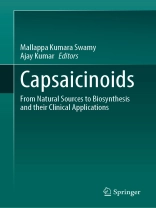This edited book brings out a comprehensive collection of information on capsaicinoids. Primarily, this book includes compiled knowledge on various aspects of capsaicin from ethnobotany to the most important clinical applications. This book covers topics emphasizing chemistry, biosynthesis, anticancer activities, bioavailability, currently undergoing experimental phases, and biotechnological methods, including cell cultures, and metabolic engineering in heterologous microbial and plant systems to enhance capsaicin production. Capsaicinoids are a group of important compounds that are particularly synthesized by various members of the genus Capsicum in their placenta. Capsaicin is the most abundant vanilloid compound among the different capsaicinoids in hot peppers. Other capsaicinoids include dihydrocapsaicin, nordihydrocapsaicin, homocapsaicin, and homodihydrocapsaicin. The capsaicin has been proven as an important bioactive molecule with several properties against many ailments, such as cancer, diabetes, obesity and diseases of the airway and urinary tract. Capsaicin interacts with TRPV1 receptors in humans. These compounds exert their functions by interacting with the TRPV receptors.
This book summarises the increasing literature surrounding capsaicin and helps to pave the way for the development of novel targets for the prevention and treatment of many disorders. It is useful for scientists, clinicians, and industry specialists working in the field of herbal therapeutics. It also assists as supplementary reading material for undergraduate and graduate students of botany, biotechnology, biochemistry, bioengineering, pharmacology, and medicine.
विषयसूची
Chapter 1. Capsaicin producing plants: species diversity, distribution and botanical details.- Chapter 2. Capsaicin: its sources, isolation, quantitative analysis and applications.- Chapter 3. Ethnobotany of capsaicin producing plants.- Chapter 4. Extraction of capsaicin and related compounds by using conventional and contemporary technologies.- Chapter 5. Analysis of capsaicin and related compounds by modern chromatographic methods.- Chapter 6. Biosynthesis of capsaicinoids in plants.- Chapter 7. Conventional propagation and micropropagation of capsaicin containing plants.- Chapter 8. Biotechnological approaches for enhanced production of capsaicin.- Chapter 9. Transcriptional regulation of capsaicin biosynthesis.- Chapter 10. Challenges in capsaicin production due to abiotic factors.- Chapter 11. Breeding for resistance to biotic and abiotic stresses and quality traits in chilli.- Chapter 12. Industrial demand and applications of capsaicin.- Chapter 13. Applications of capsaicin in the food industry.- Chapter 14. Capsaicin Receptor TRPV1: biophysics, physiology, and pharmacology.- Chapter 15. Pharmacological applications of capsaicin in the treatment of diseases.- Chapter 16. Clinical Pharmacology of capsaicin, its synthetic and semisynthetic analogues.- Chapter 17. Role of Capsaicin in Cardiovascular Diseases.- Chapter 18. Therapeutic Implications of Capsaicin in Diabetes.- Chapter 19. Anti-obesity Effects of Capsaicin via Gut Microbiota.- Chapter 20. Exploring the potential of Capsaicin in cancer therapy: in vitro and in vivo effects and their mechanism of action.- Chapter 21. The inhibitory mechanisms of Capsaicin against colorectal cancer.- Chapter 22. Elucidating the molecular mechanisms involved in regulating Alzheimer’s disease by Capsaicin.- Chapter 23. Therapeutic Effects of Capsaicin on Central Nervous Disorders with Special Emphasis on Parkinson’s and Alzheimer’s Diseases.- Chapter 24. Antimicrobial activity of capsaicin and its derivatives.- Chapter 25. Capsiacinoids – Nanoformulations for Improved Therapeutic Applications.- Chapter 26. Pharmaceutical Modifications of Capsaicin to Enhance its Bioavailability.
लेखक के बारे में
Dr. Mallappa Kumara Swamy is working as a Professor in the Department of Biotechnology at East West First Grade College (Affiliated to Bangalore University), Bengaluru, India. He has more than 20 years of teaching and research experience in the fields of plant biotechnology, microbiology, secondary metabolites production, phytochemistry, biomedicine and bioactive studies. He has published 65 research/review articles in peer-reviewed journals and 68 book chapters with reputed book publishers to his credit. So far, he has edited 17 books with publishers of international repute. He also serves as the Editorial board member and reviewer for a few high-impact international journals.
Dr. Ajay Kumar works as an Assistant Plant Science Professor at the Central University of Kerala, India. He has more than seven years of teaching and research experience and has published several research/review articles and book chapters in reputed journals and books, respectively. He has recently edited two books with Springer Nature. He has been a member of the Academic Council in the past and currently is a member of the University Court of the Central University of Kerala. He is currently a member of several academic bodies including the Board of Studies, Department of Biochemistry and Molecular Biology, Central University of Kerala.












